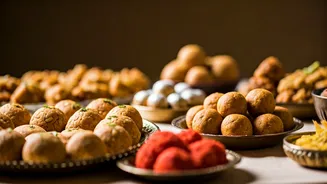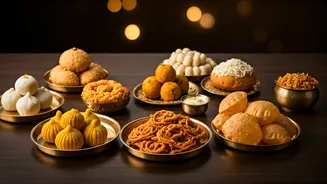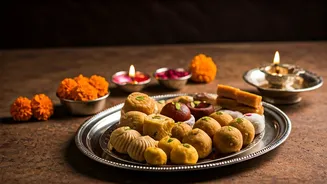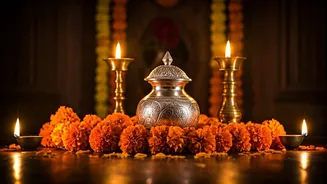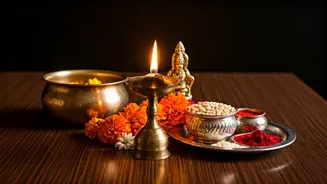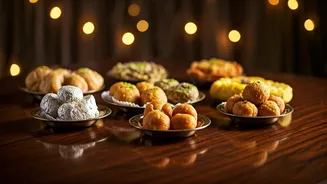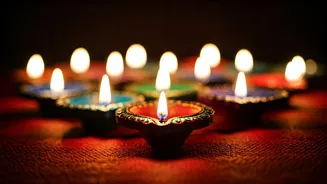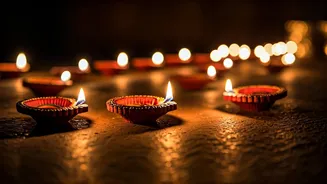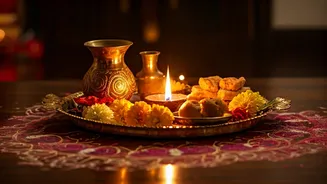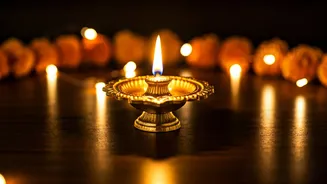Sweet Beginnings: Laddoos
Laddoos, round, sweet treats, often made from gram flour, semolina, or coconut, are a staple in Indian festivities and are especially beloved by Lord Ganesha.
These sweets symbolize happiness, prosperity, and auspicious beginnings. Offering laddoos is believed to bring good fortune and is a common practice when seeking blessings from the deities. The presence of laddoos in any puja, especially during Diwali, represents the sweet blessings and the hopeful outlook associated with new beginnings. The use of ghee, nuts, and other ingredients further adds to the richness and significance of the laddoos during this time.
The Divine Rice Pudding
Kheer, a creamy rice pudding cooked with milk, sugar, and often flavored with cardamom, saffron, and nuts, holds a significant place in the offerings made to Goddess Lakshmi. This dish represents purity, abundance, and the nourishment that the goddess provides. The preparation of kheer during Diwali signifies the wish for a year filled with prosperity and well-being. Ingredients like rice and milk are symbolic, representing the basic necessities for sustenance and the richness of life. Preparing and offering kheer during Diwali is a way to express gratitude and welcome abundance into the home.
Halwa: A Golden Delight
Halwa, a rich, dense dessert, made from semolina (sooji), wheat flour, or carrots (gajar), is another favourite offering, representing prosperity and sweetness in life. The inclusion of ghee, sugar, and various nuts elevates the offering further. Serving Halwa signifies a wish for a year filled with good fortune, happiness, and sweetness in all aspects of life. The golden color of the halwa also symbolizes wealth and auspiciousness, making it a fitting offering during Diwali, a festival dedicated to wealth and prosperity.
The Humble Coconut: Abundance
Coconuts are considered extremely auspicious and are often placed at the center of any puja or religious activity. They represent purity, wholeness, and the offering of oneself to the divine. The coconut's outer shell symbolizes the material world, while the inner flesh and water represent the inner self. Breaking a coconut during the puja signifies breaking free from the ego and offering oneself to the deities. For Diwali, a coconut represents the abundance that Goddess Lakshmi is prayed to bestow upon the devotees.
Fresh Fruits: Natural Offerings
Fresh fruits, especially seasonal ones, are essential offerings, representing the harvest of nature and the variety of life's blessings. Different fruits carry different symbolic meanings and are chosen according to the region and tradition. The presentation of fresh fruits showcases gratitude for the abundance of nature's bounty. The colors and variety of the fruits also add to the visual appeal of the puja. Offering these fresh, natural foods is a direct way to express gratitude for all that is received and pray for continued abundance.
Puffed Rice & Jaggery
Puffed rice (murmura) and jaggery are often combined and offered. Puffed rice is light and airy, and represents purity and the ease of life, while jaggery represents sweetness and good fortune. The offering of these two together symbolizes a balanced life – one that is easygoing but also filled with sweetness. During Diwali, this combination shows the desire for a harmonious and prosperous life, where both simplicity and richness can co-exist. These ingredients, being easily available, also represent the accessibility of blessings.
Savory Delights: Puri
Puri, deep-fried flatbreads, are a common offering during festivals like Diwali. They signify the abundance of food and the joyous celebration of life. The act of frying the puri symbolizes the transformation from ordinary to extraordinary, representing a commitment to celebrating the auspicious occasion. Eating puri during Diwali represents the desire for a well-nourished and prosperous life. This savoury element adds balance to the sweeter offerings, ensuring a complete and wholesome meal.
Betel Leaves (Paan)
Betel leaves, or paan, are considered sacred and are often offered after the puja. They represent respect and gratitude. Betel leaves are often accompanied by areca nut, lime paste, and other aromatic spices. Offering paan signifies the closure of the puja with respect and gratitude. The ingredients are believed to bring freshness and sweetness, and are offered as a symbol of completing the rituals with a feeling of satisfaction and blessings. The tradition of paan reflects a deep cultural connection and an appreciation for the details of life.
The Essence: Incense Sticks
Incense sticks, though not a food item, are often considered a part of the offerings because they create a sacred atmosphere, which is thought to be pleasing to the deities. The fragrance of the incense symbolizes the spreading of positivity and the uplifting of the atmosphere to welcome the divine presence. The act of lighting incense sticks also symbolizes the burning away of negative energies and the purification of the space. During Diwali, incense serves as a way to enhance the spiritual experience and create a welcoming ambiance for the festivities.
